Weird Orbs

Out of focus part of photo ‘orbing’
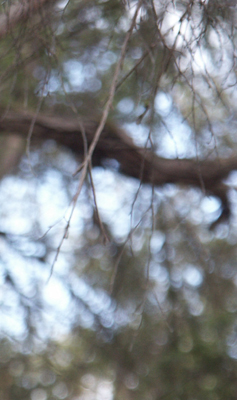
Out of focus images made with cameras don’t just go fuzzy, they turn into myriad circles of confusion (as above) but generally we don’t notice it. In the picture above, a badly focused tree is ‘orbing’ ie. it’s highlights are showing up as orbs. There were no physical circular shapes on the tree itself.
Note how the circles of confusion (effectively orbs) do NOT reflect the colour of the tree. They appear whitish compared to the green leaves and brown branches of the tree. That’s because they derive their colour from white pinpoint highlights in the picture, rather than the general object colours. This is explained below (‘orbs are not the colour of dust’).
Orbs are not dust shaped
Orbs are circles of confusion (out of focus points of light) produced by point-shaped highlights on dust particles. Since they do not reflect the whole particle, there is no reason why they should be dust particle shaped.
Single objects in a photograph will typically produce many circles of confusion (see photo top left). However, a grain of dust is very small and will generally only produce one highlight and hence one circle or confusion.
Orbs are not dust coloured
If orbs are just reflections from dust particles (or pollen), shouldn’t they be the colour of the dust particles that produced them? The short answer is no. That’s because orbs are circles of confusion based on the highlights of objects, not a reflection of the object as a whole.
Objects get their colour because they absorb certain wavelengths of light. The wavelengths reflected produce the object’s characteristic colour. However, a highlight (eg. an edge) is a tiny bit where the light is reflected completely which is why it is brighter and generally white. So orbs are always basically white (see photo below) except where there is chromatic aberration or refraction involved (see above) or a coloured light source. Blue object producing white orb
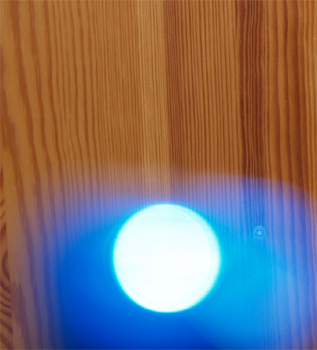
Here you see an obviously blue rectangular object producing a pure white orb from a highlight (see article above). With a much smaller object, like a piece of dust or pollen grain, only the main highlight (which produces the orb) would be visible (ie. producing a single white orb). Thus a brilliant blue piece of dust would still produce a pure white orb. Note that in the picture here the orb is circular and white which does not reflect either the shape or colour of the intensely blue object.
Strange orbs
Many paranormal researchers accept that orbs are a photographic artifact. However, some think that certain weird orbs may be something else, possibly paranormal.
Most orbs are whitish, translucent, bland and featureless like those in the tree in the out of focus picture (above). However, there are lots of other types out there.
Some people think that an out of focus area in a photograph can enhance it by blurring the distracting background in a pleasing way. It is called bokeh and it looks like the photo left.
Coloured orbs
Coloured orbs are often caused by insects. The precise mechanism is still being investigated but it probably involves refraction or diffraction.
Orbs may also be coloured by white balance ‘drift’ in the camera. If there is nothing white in the frame, auto white balance may distort colours.
Many coloured orbs pick up their hue through Moire patterns. This is an effect caused by fine patterns often found within orbs (usually concentric rings) being near to the limit of the resolution of the camera. Oddly enough, coloured orbs are becoming more common as cameras have more megapixels so showing finer detail. The patterns in the orbs are characteristic of the lens. Every lens has minor imperfections, so each will produce its own characteristic patterns within orbs (which are, of course, circles of confusion). You can see typical fine concentric circles in the top orb in the ‘fluffy orb’ photo, right - you might even be able to see rainbow coloured Moire patterns in it if you look carefully. Photo software packages can remove Moire patterns without affecting the rest of the picture.
Most orbs are reported on low resolution, compact digital cameras which have a physically smaller CCD. However, it is the higher resolution cameras that are more likely to produce coloured orbs. This is because the resolution is closer to the fine detail in the orbs, so producing Moire patterns.
A compact camera with a small chip but high resolution (an increasingly common combination) can produce a spectacular multitude of orbs of many different colours. It is difficult to predict exactly what the colours will be.
A less common cause of multicoloured orbs is chromatic aberration. This a problem with lenses refracting different wavelengths of light to different degrees. It is corrected in most cameras but can appear in photos taken with economy models. It shows up as faint coloured edges to orbs.
Another causes of orb colours is electronic noise (when using high ISOs). When orbs are caused by water, such as rain drops, you can get also get colours caused by refraction. The water drops are acting as uncorrected lenses (see photo below).
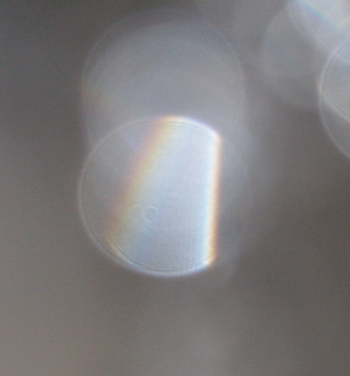
Oddly shaped orbs
A number of factors can cause orbs to be shapes other than a circle. One is spherical aberration, a problem with any lens to some extent. This (or attempts in the lens design to correct for it) can produce orbs with haloes, fuzzy edges and even strong concentric rings. It afflicts economy cameras more than others.
Another, more common cause of odd shaped orbs is ‘truncation’ (or the ‘cat’s eye effect’). This makes orbs appear truncated on one side near the corners of the photo frame (and sometimes the frame edges, depending on the camera). The truncated edge always faces outwards away from the centre of the frame. The effect is more properly known as optical vignetting.
Look, for instance, at the truncated orbs in the picture below. This is a corner of a much larger photograph. All the orbs in the photograph are circular except those in the corners. The effect is caused by light from the orbs being lost in the barrel of the camera lens (see diagram bottom).
If you see a photo with lots of orbs all over it, check those near the edge of the frame. Truncation in the corners betrays the orbs as circles of confusion.
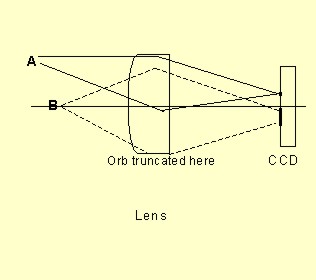
Light from very close objects, like orbs, is lost when it hits the barrel of the lens. This truncates the orb when it arrives at the CCD.
Orbs with bits missing
Sometimes orbs can appear that seem to have bits missing. There are ‘bites’ missing out of their sides or holes in the middle, like a doughnut.

In the photo above you can see examples of both of these sort of orb. So what’s going on here?
If you look carefully (unfortunately it’s not a great picture) you will see that there are many faint overlapping orbs. The orbs are all different sizes and brightness because the objects causing them are at different distances from the camera. The resulting orbs overlap, getting in front of and behind each other. This produces the effect whereby chunks appear to be missing. The effect is particularly noticeable in water orbs. Orbs may be close, like this, if a single object produces multiple highlights.
Fluffy orbs
It’s possible to get orbs with fluffy edges (a sort of halo effect) rather than usual sharp curves (see pic below).
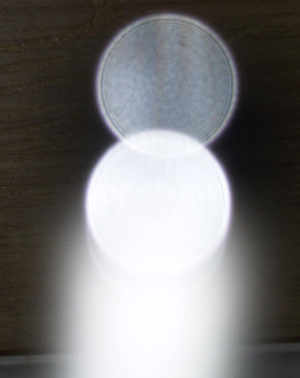
This effect happens when the object causing the orb is highly reflective. The halo is caused by too much light being reflected back to camera from the flash. The ‘halo’ is an overexposed area while the background is underexposed. This is an exaggerated example. A typical ‘natural’ fluffy orb would be smaller. The camera overexposes the orb because it only forms a small part of the overall photo frame (which it uses to decide how long to keep the flash going). Note the faint coloured lines in the top orb. These are Moire Patterns (see ‘Coloured Orbs’)
Truncated orbs
As explained in ‘oddly shaped orbs’ (left), orbs are typically truncated in the corners of photos. Here is a photo of of the effect.
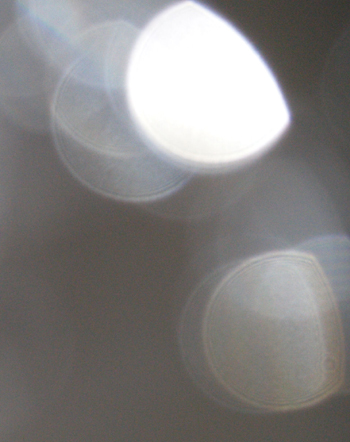
Truncated orbs in the corner of a photo. In the diagram, left, light from the orb, B, arrives at a steeper angle because it is so close to the lens. As a result some of it is lost when it hits the edge of the lens and it never reaches the CCD. The object A, which is further away and in focus, loses no light and is shown accurately.
Truncation (or optical vignetting) is circular because the barrel of the lens is circular. Truncation occurs mostly in the corners of photographs, and sometimes the edges, because the light is being projected by a circular lens onto a rectangular CCD. It may not occur in all cameras - it depends on the design. The truncation is called the ‘cat’s eye effect’ by photographers.